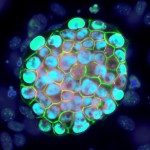Lien vers Pubmed [PMID] – 9659932
Dev. Biol. 1998 Jun;198(2):266-76
The recessive patchwork (pwk) mutation in mice is associated with a unique hair follicle phenotype. Mice homozygous for patchwork exhibit a variegated coat containing a mixture of white and fully pigmented hairs, but no partially pigmented hairs. We have investigated the etiology of this mutation. We report here that the white hairs result from the lack of melanocytes in the follicle. As indicated by the coat color pattern of patchworkalbino chimeras, the target cell for the patchwork mutation is the melanocyte and/or its precursor. Examination of these chimeras also suggested that patchwork does not act in a cell-autonomous manner. The colonization of the skin by melanoblasts in patchwork embryos was studied using a lacZ transgene. Melanoblasts die by apoptosis in hair follicles from homozygous pwk/pwk fetuses starting at embryonic day 18.5, indicating that patchwork acts from this stage. The combination of pwk and KitW-ei, a mutation responsible for a reduced number of melanoblasts in the hair follicle, suggested that pwk gene product is necessary for low numbers of melanoblasts to survive and differentiate in the hair follicle from embryonic day 18.5 onward. We conclude that the pigmented hairs on the coat of pwk/pwk mice may be attributed to a community effect among melanoblasts in the hair follicle at the end of embryogenesis.

